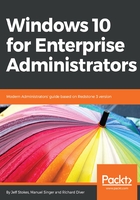
Current Branch for Business, also known as Semi-Annual Channel
When speaking of the defer option, a lot of sources mix it up with the Current Branch for Business (CBB). But this is only partially correct. When a new Windows 10 version is released, it is automatically CB. After around 4 months, when several cumulative updates have ironed out all remaining hiccups or when a newer version is released, the ISOs will be updated and the CB will be declared as CBB. So CBB is not different in its bits and bytes; it's just updated media and a different name.
This branch was renamed with Windows 10 1709 to Semi-Annual Channel.
Organizations can selectively delay CB and CBB updates into as many phases as they wish (also called a ring model) using one of the servicing tools mentioned in the CB section. Deferring a version long enough will result in it being on an older branch than the current CBB. If you now name it just CBB, it could be misleading.
We should instead always speak of a CB or CBB with its version (for example, CBB 1703) or as CBB and CBB+1, where CBB+1 is the older version. I prefer the year year month month (YYMM) versioning. Also naming convention of CBB/CBB+1 will be completely replaced with 1709 by Semi-Annual Channel (Targeted) and Semi-Annual Channel (without any extension). So beginning with Windows 10 1709 we should speak about Semi-Annual Channel 1709.
So, when you are able to defer feature updates as long as you want, how long is such a CBB / Semi-Annual Channel version supported and getting security updates?